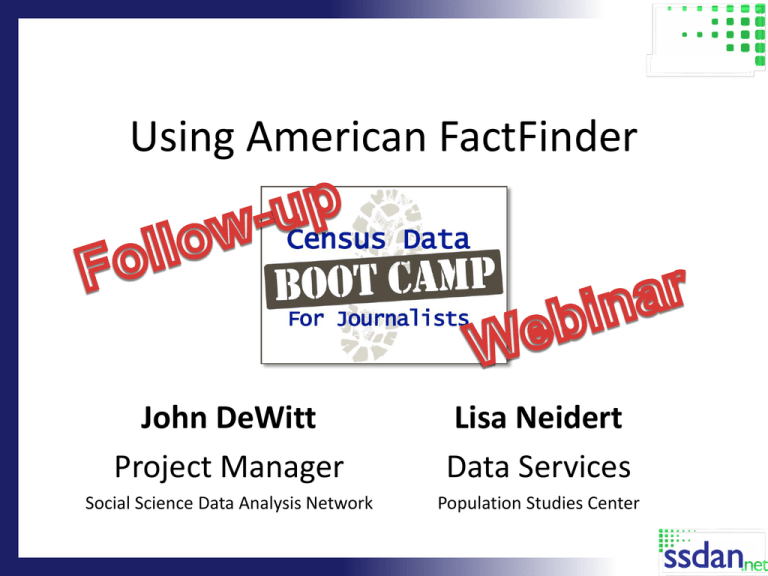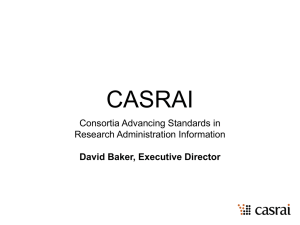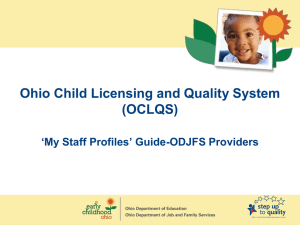
Using American FactFinder
John DeWitt
Project Manager
Lisa Neidert
Data Services
Social Science Data Analysis Network
Population Studies Center
What is American FactFinder?
• http://factfinder.census.gov
• Main portal to most popular data from U.S. Census Bureau
–
–
–
–
–
Decennial census
American Community Survey
Puerto Rico Community Survey
Population Estimates
Economic Census and Surveys
• Multiple data products
– Several indicators across geographies
– Many indicators for a single geography
• Occasionally difficult to link “data” to “information”
– Trends
– What product to use?
Since the Oct. 2009 Boot Camp…
• ACS 2009 Release:
– 1-Year Summary File , September 2010
1-Year Public Use Microdata Sample (PUMS) Files,
November 2010
– 5-Year Summary File, December 2011
1-Year & 5-Year Spanish Version of Puerto Rico Community
Survey Data Release, December 2010
– 3-Year Summary File, January 2011
3-Year Spanish Version of Puerto Rico Community Survey
Data Release, January 2011
Release Schedule for ACS Data
Release Schedule for ACS Data
Year of Data Release
Data Product
Population Threshold
2006
2007
2008
2009
2010
2011
2012
2013
2008
2009
2010
2011
2012
20072009
20082010
20092011
20102012
20052009
20062010
20072011
20082012
Year(s) of Data Collection
1-year
Estimates
65,000+
3-year
Estimates
20,000+
5-year
Estimates
All Areas*
2005
*Five-year estimates available for Census Tracts & Block Groups
Source: ACS General Data Users Handbook
2006
2007
20052007
20062008
Census 2010 Releases
• 2010 Demographic Analysis Population
Estimates, December 6th 2010
• Apportionment Announcement to President,
December 2010
• Census Demographic Profiles, March 2011
• 2010 Summary File (SF1) begin release, June
2011
• 2010 Summary File (SF2) begin release,
December 2011
CensusScope Updates
American Fact Finder in 2011
• 2011 will bring
some changes
to the Fact
Finder website:
American FactFinder
•Fact Sheetsquick stats for a town,
county or zip code
•“Get data” linksmany of AFF’s data
products
•Download centerquick downloads
of detailed tables for all available states,
counties, metro areas, etc.
Fact Sheets (Data Profiles)
•Quick lookup
•Many common indicators
•Includes U.S. numbers for comparison
Aggregate Products are the
most commonly used data
products available from
the ACS. These include the
tables and maps in the
American Factfinder, which
describe the distributions
for basic and detailed
population and household
queries.
Detailed Tables
These are where experienced
journalists go first to find the
estimates they need. In the American
FactFinder, these tables are known as
the detailed and custom tables and
include the most descriptive and
detailed data. These tables feature
simple frequency estimates for
individual variables and estimates for
combinations (such as poverty status
by sex and age). Many variables in the
detailed tables, such as age, are
subdivided into several categories
(such as ages 0–17, 18–64, 65 and
older, and so on). Detailed tables can
also be obtained through FTP.
automatically
inserted
into
a
preformatted text.
Detailed Tables
Select multiple
geographies.
Detailed Tables
Select
multiple
tables.
See multiple
geographies
side-by-side
Scroll to see
other selected
tables.
Detailed
Tables
Detailed Tables
Collapsed table
A detailed table with a reduced amount of detail
shown to comply with data release rules. Specifically,
it is a detailed table with a "C" prefix for which two or
more lines of data from the corresponding "B" prefix
table have been collapsed into a single line in the "C"
table. Not every B table has a collapsed version.
Downloading from AFF
FIPS Codes: A slight diversion
FIPS
•Federal
Information
Processing
Standards (FIPS)
•Issued by National Institute of
Standards and Technology (NIST), now
updated by American National
Standards Institute (ANSI)
•Useful for mapping and databases
Subject Tables
These are summarized, topicspecific tables based on data from
the detailed tables. They are easier
to navigate and can be a better
choice if you just need a quick
overview, or if you’re new to the
ACS. Subject tables provide data for
some of the most popular topics,
such as finances, households, and
occupational characteristics for a
single geography. If your questions
is simple, subject tables may
provide the data you need with a
minimum of fuss.
Subject Tables
Select only one geography.
Browse by subject or
select a table below.
Subject
Tables
Subject
Tables
Ranking Tables
These tables compare the 50
states, the District of Columbia,
and Puerto Rico according to
various characteristics and rank
them from highest to lowest.
Ranking tables present state data
from
nearly
100
different
characteristics. These tables can
also be viewed as charts, using a
link on the page. The charts show
the 90-percent confidence limits
around each estimate as an
indication of which rankings may
be statistically different (meaning
the two estimates probably are
truly different.)
Browse by
subject or
select a table
below.
Ranking
Tables
Sort alphabetically by State or
numerically by Ranking.
Ranking
Tables
Geographic Comparison Tables
These are similar to ranking tables
but are available for geographical
levels that extend below the state
level. Unlike ranking tables, they
provide margins of error for the
estimates but do not tell you
whether or not the differences in
rankings are statistically significant.
Geographic Comparison Tables
Select a geographic area (Nation or
State), and then the table format, or
the geography you want to compare.
Here we are choosing to compare all
of the counties in Michigan.
Geographic Comparison Tables
Select only one
Comparison Table.
Geographic
Comparison
Tables
Data Profiles
This product offers tables that
provide summaries of several basic
social, economic, housing, and
demographic characteristics for
each geographic unit. While they
are less sophisticated than
detailed tables, data profiles do a
good job of describing the broad
characteristics of a geographic
area.
Data Profiles
Select only one geography.
Select different profiles to
see economic, housing, or
demographic data tables.
Data
Profiles
Scroll to see more
information.
Narrative
Profiles
Accessible through data profiles
are narrative profiles, which
present the data in plain
language and use graphics,
similar to a news article. These
products contain data that are
automatically inserted into a
preformatted text.
Selected Population Profiles
Population profiles are readymade tabulations for specific
groups of interest, such as a
specific ancestry or race. While
other ACS profiles provide general
information for a geographic area,
the selected population profiles
use a similar format to provide
basic information for a specific
segment of the population.
Selected Population Profiles
Select multiple
geographies.
Selected Population Profiles
Select the specific
population group
you want to look
at. You can choose
from Race or
Ethnic groups,
Ancestry groups or
Country of Birth.
Selected
Population
Profiles
Scroll to see more
information.
Thematic Maps
The maps include two important
features in addition to their
categorical color schemes. First,
users can quickly identify which
other geographic units have a
significant statistical difference
from the selected unit for a
particular characteristic.
Also,
tabular interfaces to the data are
readily available as a link on the
left of the page.
Thematic Maps
Select only one geography.
Thematic Maps
Select only one
Thematic Map.
Thematic
Maps
Use the zoom feature to
see a more detailed map.
Change the geography
displayed. Other options
include Congressional
Districts, Metropolitan and
Micropolitan Statistical
Areas and Public Use
Microdata Areas.
Comparison Profiles
The comparison profiles show data
side-by-side from the 2006 ACS
and the 2007 ACS, indicating
where there is a statistically
significant difference between the
two sets of estimates. Comparison
profiles are only available for 1year estimates.
Comparison Profiles
Select only one geography.
Comparison
Profiles
Select different profiles to
see economic, housing, or
demographic data tables.
Compare data
across the years.
Some data is not
able to be
compared
accurately, in this
case the 2007 and
2008 3-year
estimates.
Download
Center
Use the download center to quickly
download large amounts of data.
The download center allows users
to download up to 50 tables for a
single geography at a time, or you
can download all the summary file
extracts for all the tables. The
individual tables download as zip
file with pipe-delimited text files.
Download Center
Select only one
geography at a time.
Select the aggregate
product, or data
visualization, you
want to download.
Download Center
Select up to 50
different tables
to download.
Download Center
Sample Tasks
• How could you get a demographic overview of your
local county, city, or state?
• What FactFinder product would allow you to look at
median age of first marriage for your multiple
counties, a state, and the U.S. all at once?
• What state has the largest percentage of population
that has completed high school?
• Which FactFinder product allows a user to download
multiple files for all available geographies of specific
summary level (e.g. counties, metropolitan and
micropolitan areas, etc)
Questions?







